

|
Back to |
| The Front Page |
| News & Features |

|
Croquet at the Olympics:
Paris, 1900 by Chris Hudson Posted February 9, 1999 |
Although 1225 "athletes" competed in the second Olympics of the modern era in 1900 in Paris, historians concede that it was a poorly organized and monumental failure in most respects. It was here, however, that croquet, a sport "with hardly any pretensions to athleticism" according to the official report, was introduced to the Olympics. The Parisian croquet players forestalled competition from overseas by spreading the croquet over many weeks; there was only one paying spectator - an English gentleman. Organized croquet and the Olympic Games have both matured immeasurably in the last 100 years, but croquet - at last on the brink of becoming a truly worldwide sport - will be nowhere in evidence in Sydney at the quadrennial games in 2000. Chris Hudson, Secretary-general of the World Croquet Federation, researched the history of croquet's inauspicious Olympic debut for the WCF Newsletter WORLD CROQUET, from which is adapted the following article.
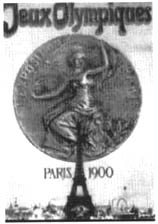
|
| The cover of the official program for the 1900 Paris Olympic games. |
For years, people have talked vaguely about croquet having been part of the Olympic Games held in France; of 600 French competitors; of its disappearance from the Olympic scene. But what was the real story? Did it ever happen? Which Olympics was it? Who was the Olympic Champion, and what were the results? Here are the facts!
Baron Pierre de Coubertin is regarded, rightly, as the father of the modern Olympic Games. To him, the amateur ideal was paramount, underlining the "noble and chivalrous character" of physical exercise. Rewards had to come from the sporting activities themselves. However, the effect of this policy - no material gifts, no desire for profit, no business interest in sport - was to limit the games to the aristocracy, who could afford to pursue sporting activities in this way. A matter, incidentally, that was to lead to trouble later when the lower social classes refused to be excluded!
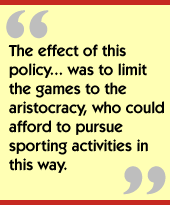
Coubertin first raised the idea of reviving the Olympic Games in 1892, but
his enthusiasm met with little comprehension. Undeterred, he invited
interested persons from all over the world to participate in a sports
congress in Paris in 1894, which passed a unanimous resolution to revive the
Olympic Games in Athens in 1896. The plan was that, after Athens, the
competition would be hosted by all capitals in turn at four-year intervals.
The Olympics resume in Athens - without croquet
The games in Athens were held from 6th to 15th April, 1896, and were attended by 211 competitors representing 14 countries. 40,000 spectators attended the Opening Ceremony. Many athletes entered privately, including holidaymakers, and the British contingent included two employees of the Embassy in Athens. The events included athletics, gymnastics, wrestling, cycling, and pistol shooting.
Events in the stadium were dominated by the United States. The U.S. team was composed entirely of college students who arrived only the day before the competition, having traveled by ship to France, then by train to Greece. They won 11 gold medals; Greece came second with 10.
Paris Olympic Games reduced to a sideshow
After such a promising start in Athens, the games of 1900 proved to be a disappointment. Despite strong Greek pressure for the exclusive rights to organise future games, Coubertin stuck to his guns and won agreement for the second modern Games to be held in Paris. However, he made the serious mistake of making them part of the 5th Universal Exposition that was also being held there in 1900. In the event, the Games simply became a sideshow to the Fair. An additional complication was that numerous internal rivalries within French sport left many of the sports without experienced officials or adequate venues.
Generally there were few spectators, and those who had bothered to make the trip had a lucky escape when the 1896 discus champion despatched the implement into the crowd on all three throws. Cricket, croquet, and golf made their appearance at these Games, but amid the general confusion many competitors, even medal winners, were not aware until much later that they had been competing at the Olympics. Because the Games were linked in with the Exhibition, they actually ran from 20th May until 28th October, 1900, an incredible length of time.
France, the host nation, fielded 884 competitors, the largest team ever entered for the Games. The decision to hold competitions on Sundays upset many athletes, who refused to compete. Woman were allowed to compete for the first time, but not in the major sports. (Great Britain's Charlotte Cooper, one of the 19 women competing and a Wimbledon champion, won the ladies' tennis title on 9th July.)
Another unique record was set in the coxed pairs rowing final, in which a small French boy was drafted in at the last moment to cox the winning Dutch crew. His name was never recorded and he disappeared without trace afterwards, but he was no more than 10 years old, and possibly as young as 7, in either case the youngest ever Olympic Gold medalist.
Press coverage was barely apparent, with many of the events not mentioned at all, and for years afterwards there was much confusion as to the names and nationalities of even the medalists. In the medals table, France won 27 Golds, with the USA in second place with 19 and Great Britain third with 17. In all 1225 competitors took part, representing 26 countries.
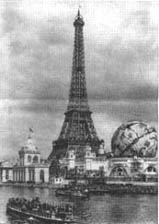
|
| Symbols of the 1900 World Exhibition were the Eiffel Tower, erected for the World Exhibition of 1889, and a huge globe which has not survived to the present day. |
The athletics events, held at Croix-Catalan in the west part of Paris, encountered problems. The athletic programme was due to start on Saturday 14th July, Bastille Day, but fearing that the general public would be too interested in enjoying themselves to bother with the Games, the organisers at the last minute delayed the start by one day. Many athletes complained that they were not prepared to compete on a Sunday. Several of the athletics events suffered as a result of competitors not being prepared to put fleeting glory above their religious beliefs.
Two of the field events were reduced to farcical proportions, showing the innocence of the times and the organisers' lack of experience in running major competitions. Sophisticated Paris folk split their sides with amusement at the antics of some of the so-called Olympic sportsmen in the discus and hammer events. The organisers had located the events down a narrow avenue of trees on the Bois de Boulogne, thus forming a perfect trap for every discus and a snag for every hammer wire. Rarely can such precision have been required to win Olympic Gold.
For many reasons, the Games were thus more of a charade than a festival of Olympic excellence. Even the first long-awaited French success - in the marathon - ridiculed the concept of Olympism: The Champion was not officially declared until 12 years later!
Michel Theato, a Paris baker's roundsman, won a controversial race in stifling temperatures. He was rumoured to have accepted participation money, and with one of the American runners filing an unsuccessful, though prolonged, lawsuit against the IOC, his was a somewhat hollow triumph.
Even more bizarre was the case of the French cyclist Vasserot, who on being tracked down in 1965, recollected a race in 1900 but then admitted he had been unaware at the time that he was competing in the Olympic Games.
Swimming with the current in the Seine
As the Games continued, so too did the confusion. The myriad of events, many of which only vaguely passed for sport, detracted from serious attempts to give the Games global respectability. It became increasingly difficult to take some events seriously. In swimming, for instance, the men's 200M freestyle race was, like all other races, held in the muddied waters of the Seine where, incredibly, races were swum with the current. There was an obstacle race where the chief requirement was to climb a pole and then swim over and under a row of boats. Underwater swimming was another novel twist thrown in by the organisers, who did much to demean the Games.
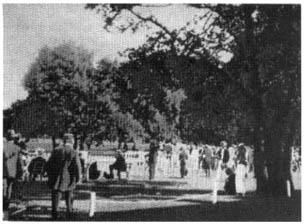
|
| It was often rather by chance that passers-by came across the sporting events taking place at various places across Paris. Even the athletes themselves seem to have had little chance to savour the Olympic spirit that should have pervaded this meeting of the "youth of the world" |
Military events, such as shooting and fencing, enjoyed great prominence, and the Games encompassed other sports that thereby enjoyed a fleeting acquaintance with the Olympic movement. Like croquet, all of them were the preserve of the well-to-do, a further reflection of where the emphasis lay in terms of which sports were admitted to the Games.
Despite the farce, some atheletes achieve Olympic excellence
Though posterity was to judge the Paris Games of 1900 as the worst on record, there were performances that deserved acclaim: The Swedish gymnastic team demonstrated new styles and technique; a United States athlete, Alvin Kraenzlein, introduced the leg-extended style in hurling.
But Coubertin's gamble to exploit the Exhibition as a means to protect the Games had failed miserably. If history sees him in a more favourable light today, it is because his refusal to capitulate to demands for a permanent site for the Games in Athens has come to be seen as a momentous triumph for diversity - the enduring beauty of the Olympic games.
Coubertin did not have the benefit of hindsight when he made his final summation of the games: "There was much goodwill, but the interesting results had nothing Olympic about them. We made a hash of our work."
Nevertheless, the official report of the Games itemises the number of competitors taking part in each event, and when school competitions, military manoeuvres, balloon racing and the like are taken into account, nearly 60,000 people had taken part in the activities. Quite a triumph in itself.
Excerpt from The Official Report of the 2nd Olympic Games
"This game, French in name and origin (though some writers, more fashionable than athletic and more 'snob' than well-informed, affect to call it 'crocket') has hardly any pretensions to athleticism and the reason it joined the USFSA (The Union of French Sports Clubs) is due to the fact that its governing body wished to elevate this gentle pastime to the rank of a sport by holding annual croquet championships.
"One would be wrong, however, to disdain croquet. It develops a combinative mind - one has only to see it transform young girls into reasoners, and from reasoners into reasonable people.
"Mr. Andre Despres, civil engineer by profession and the legislator of croquet, lavished the most enlightened and devoted care on the Exhibition tournament. Baron Gourgaud provided him with a sand court built specially for the occasion, not without expense, in a pretty corner of the Cercle du Bois de Boulogne. The best players in Paris competed there, and were very pleased with the facilities.
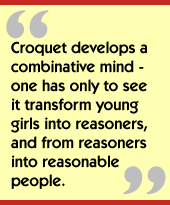
"One must admit that there were not many players; about a dozen. The obstinacy of the Paris "set" in spreading the different competitions over several weeks totally ruled out any players from the provinces and overseas. Spectators were not at all numerous; although I must mention an English lover of the game who made the journey from Nice to Paris to watch the first matches of the competition; unless I am very much mistaken, however, this gentleman was the only paying spectator.
"The Exhibition competition did however have one result; it brought together players who did not know each other and enlarged this sport's rather restricted group of experts."
Details of the Croquet Competition
According to the Official Report, croquet events included not only singles and doubles, but also handicap and "one-ball" play, as detailed below:
"Six people made up the Technical Commission in charge of croquet at the Games: Messrs Despres, A. Foucault, G. Foucault, Gaullet, Dumont, Johin, and de Saint-Cyr.
"Play started on Wednesday 24th June, and continued every Sunday thereafter until 15th August. There were four events:
"Singles Championship with one ball on points:
Prize - 1 Souvenir Medal.
Winner - Mr Aumoitte. 2. Mr Johin. 3. Mr Waydelich.
"Singles Championship with two balls per side:
Prize - A presentation croquet set, a Souvenir Medal and 2 presentation mallets.
Winner - Mr Waydelich. 2. Mr Vignerot. 3. Mr Sautereau.
"Doubles Championship:
Prize - 4 presentation mallets, 2 Souvenir Medals.
Winner - Messrs Johin and Aumoitte.
"Singles Handicap with two balls:
[Prize -]1 Souvenir Medal.
Winner - Mr Vignerot.
"Entry fees: Singles Championships - 3 francs; Doubles Championship - 5 francs per team; Handicap - 1 franc. [Editor’s note: 3 francs in those days was worth about £5 sterling today.]
"Entry closing date: 31st May, 1900.
"Venue: Cercle du Bois de Boulogne (Pelouse de Madrid)."
ACKNOWLEDGMENTS
Thanks are due to the British Olympic Association for their generous help in making their library facilities available. The material and information in this article has been gleaned from the following books, which are highly recommended to anyone interested in the history of the Olympic Games.
"The Golden Book of the Olympic Games" by Erich Kamper and Bill Mallon. Published 1992 by Vallardi and Associati, Milan.
"Olympics Facts and Feats" by Stan Greensberg, published 1996 by Guinness Publishing Ltd.
"The Chronicle of the Olympics 1896-1996," published by Dorling Kindersley.
"The 100 years of the Olympic Games," (4 volumes) in German, English (by Iain MacLeod), French, and Italian, published by the International Olympic Committee.
"The Official Report of the 2nd Olympic Games"
[The foregoing article is adapted from WORLD CROQUET, newsletter of the World Croquet Federation, and printed here by permission.]